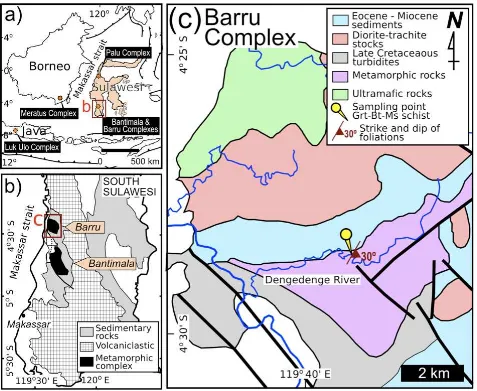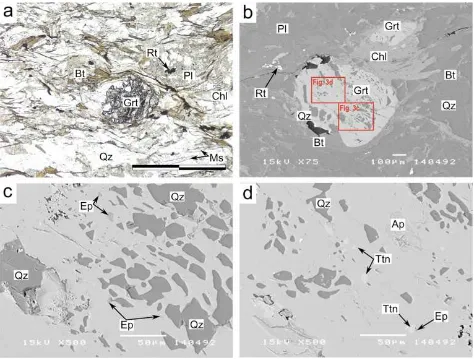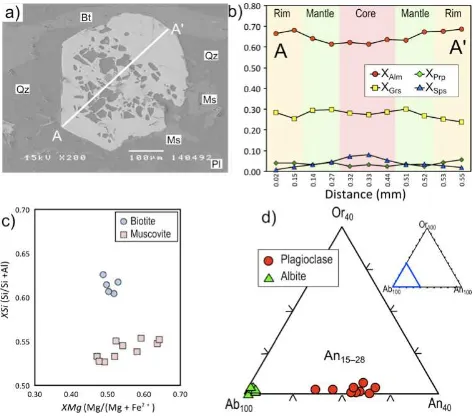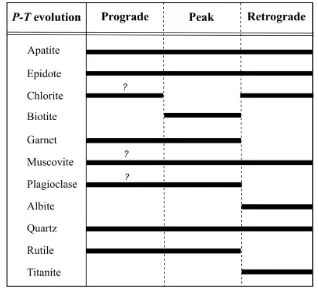J. SE Asian Appl. Geol., Jul–Dec 2014, Vol. 6(2), pp. 68–78
METAMORPHIC EVOLUTION OF
GARNET–BIOTITE–MUSCOVITE SCHIST FROM
BARRU COMPLEX IN SOUTH SULAWESI,
INDONESIA
Nugroho Imam Setiawan*1, Yasuhito Osanai2, Nobuhiko Nakano2, and Tatsuro Adachi2
1Geological Engineering Department, Faculty of Engineering, Universitas Gadjah Mada, Yogyakarta, Indonesia. 2Division of Earth Sciences, Faculty of Social and Cultural Studies, Kyushu University, Fukuoka, Japan.
Abstract
This paper explains the first report in metamor-phic evolution of pelitic schist from Barru Com-plex in South Sulawesi, Indonesia. Garnet-biotite-muscovite schist was examined petrologically to as-sess the metamorphic evolution history, which has implications on tectonic condition of this region. The rock mainly composed of garnet, biotite, muscovite, epidote, quartz, rutile, hematite, and plagioclase. In-clusions in the garnet preserve records of prograde stage of this rock, which are epidote, titanite, quartz, and apatite. Garnet, biotite, muscovite, quartz, ru-tile, and plagioclase are concluded as equilibrium as-semblages at peak P-T condition of this rock, which estimated at 501–562 ºC and 0.89–0.97 GPa. The result is still on the ranges of the estimated geother-mal gradient P-T path of eclogite from Bantigeother-mala Complex. Similar geothermal gradients of metamor-phisms might be indicated that these metamorphic rocks were metamorphosed on the similar tectonic environments.
Keywords: Pelitic schist, Barru Complex, South Sulawesi, metamorphic evolution.
*Corresponding author: N.I. SETIAWAN, Geological
Engineering Department, Faculty of Engineering Uni-versitas Gadjah Mada. Jl. Grafika No. 2, Bulak-sumur, Yogyakarta 55281, Yogyakarta, Indonesia. E-mail: nugroho.setiawan@ugm.ac.id
1 Introduction
Accretionary units and regional metamorphic rocks crop out in South Sulawesi. Those are exposed in restricted area namely Bantimala and Barru Complexes. Bantimala Complex is well-known to be worldwide outcrop of high-pressure and ultra-high pressure meta-morphic rocks (eclogite, blueschist; Sukamto, 1982; Wakitaet al., 1994a, 1996; Miyazakiet al., 1996; Parkinson et al., 1998; Setiawan, 2013). Whereas 30 km north of this complex, low-to medium-grade metamorphic rocks expose in more restricted area namely as Barru Com-plex. However, there were lacks of publications about metamorphic rocks from Barru Complex in particularly their metamorphic evolution.
This paper explains the occurrence of garnet-biotite-muscovite schist from Barru Complex. Detailed assessment of chemical zonation and inclusion texture of euhedral garnet and as-sociated minerals are well correlated to the metamorphic evolution history. Furthermore, the manuscript attempts to interpret the tec-tonic implications of this metamorphic rock in comparison with other terranes in South Su-lawesi. Mineral abbreviation in this paper fol-lows Whitney and Evans (2010).
2 Geological outline
units such m´elanges, pillow basalts, dismem-bered ophiolites, cherts, serpentinites, high-pressure metamorphic rocks, and occanion-ally granulites and garnet lherzolites are spo-radically exposed in central Indonesia region through Java, Kalimantan, and Sulawesi Islands (Sukamto, 1982; Wakita et al., 1994a, 1994b, 1996, 1998; Miyazakiet al., 1996, 1998; Parkin-son, 1998a, 1998b; Wilson and Moss, 1999, Kadarusman and Parkinson, 2000; Kadarusman
et al., 2005). The distribution of the accretionary units and metamorphic rocks are shown in Figure 1a. Most of the metamorphic rocks ex-posing in the complexes occur in a limited areas and is bounded by the thrust fault with other units such as dismembered ophiolites, cherts, m´elanges, and serpentinites (Sukamto, 1982; Asikin et al., 2007; Sikumbang and Heryanto, 2009). In the South Sulawesi, the metamorphic rocks crop out in the restricted area namely as Bantimala and Barru Complexes (Figure 1b). The Bantimala Complex in South Sulawesi has significantly important meaning for one of the famous high-pressure metamorphic terranes in the world. Furthermore, Parkinson et al., (1998) reported ultra-high pressure metamor-phic rocks, which is garnet-jadeite-quartz rock that experienced peak metamorphism at >2.7 GPa on 720–760 °C from this complex.
The Barru Complex is located approximately 70 km northeast of the Makassar (Figure 1b). Metamorphic rocks in this area are bounded in the north with ultramafic rocks and in the south with Late Cretaceous sedimentary rocks (Figure 1c). The most common lithologies in this area are variably of garnetiferous quartz-mica schist and serpentinized peridotite. Most of the meta-morphic rocks crop out along the Dengedenge River (Figure 1c). Reliable P-T condition of the metamorphic rocks in this area has not been re-ported previously. Wakitaet al.(1994a) reported the phengite K-Ar age of the quartz-mica schist to be 106 ± 5 Ma, which interpreted as exhuma-tion ages.
3 Occurrence and sample descriptions
The exposures of the metamorphic rocks in the Barru Complex are well preserved along the
Dengedenge River (Figure 1c). The foliation of garnet-biotite-muscovite schist varies from N 80° E to N 30° E with dipping 30° to 60° to the east (Figure 2). Petrographical and mineral chemistry analyses were done on the garnet-biotite-muscovite schist with sample number 031202A. Mineral chemistries were analyzed with a JEOL JXA-8530F hyperprobe EPMA and a JEOL JED2140-JSM5301S scanning electron microscope with energy dispersive spectrom-etry system (SEM-EDS) in Kyushu University, Japan. The analytical conditios of EPMA was set an accelerating voltage of 15 kV, a probe cur-rent of 12 nA and a beam diameter of 2 μm.
The analytical conditions of SEM-EDS JED2140-JSM5301S was set at an accelerating voltage of 15 kV, a probe current of ca. 0.35 nA, and a beam diameter of 1 μm. Natural mineral
sam-ples (ASTIMEX-MINM-53) and synthesized ox-ide samples (P and H Block No. SP00076) were used as standards for the quantitative chemi-cal analyses. Fe3+
contents of garnet and pla-gioclase were calculated using algorithms pro-posed by Droop (1987). Micas formulae have been calculated to eleven oxygen atoms assum-ing all iron to be Fe2+
. Cation formulae of epi-dote and titanite have been calculated assum-ing all iron to be Fe3+
. Representative chemical compositions of the analyzed minerals are listed Table 1.
The garnet-biotite-muscovite schists are mainly composed of garnet, biotite, muscovite, epidote, quartz, rutile, hematite, and plagio-clase. The schistosity is defined by alignments of muscovite and biotite (Figures 3a–b). Garnet porphyroblasts (∼0.3 mm in diameter; Prp2−6, Alm61−69, Sps1−8, Grs24−30) have inclusions of quartz, titanite, apatite, and epidote [XFe3+ =
Fe3+
/(Fe3+
SETIAWANet al.
SETIAWANet al.
Figure 2: Mode of occurences garnet–biotite–muscovite schist in Dengedenge River of Barru Com-plex, South Sulawesi.
and muscovite (0.1–0.5 mm; XMg = 0.52–0.67,
XSi = 0.53–0.61) (Figure 4c). Microcrystalline quartz occurs as pressure shadow adjacent to the garnet (Figure 3a). Plagioclase (0.2–0.7 mm in diameter; An14−26 Ab72−85) forms abundant porphyroblasts in this schist (Figure 4d). Rutile (<0.1 mm), which present in the matrix, is com-monly rimmed by titanite. Secondary chlorite [Fe2+
/(Fe2+
+ Mg) = 0.47–0.53] commonly re-places garnet porphyroblasts, micas, and other minerals (Figure 3b). Calcite and albite (XAb = 0.99–1.00; Figure 4d) occur as interstitial. The petrography and mineral chemistry analyses result of mineral assemblages in garnet-biotite-muscovite schist is summarized in Table 2.
4 Metamorphic evolution
The metamorphic evolution of garnet–biotite– muscovite schist from Barru Complex is esti-mated based on the mineral coexistence from the petrographical observation. Inclusions in the garnet preserve records of prograde stage of this rock, which are epidote, titanite, quartz and apatite. However, it is lack of mineral parageneses in the prograde stage to constraint the pressure-temperature condition. Hence,
only peak metamorphic condition could be es-timated from this rock. Garnet, biotite, mus-covite, quartz, rutile, and plagioclase are con-cluded as equilibrium assemblages at peakP-T
condition of this rock.
Metamorphic temperature is estimated us-ing garnet-biotite geothermometer proposed by Holdaway (2000) based on the Fe2+
SETIAWANet al.
Table 2: Summary of mineral assemblages with their stage of metamorphism.
mometer and garnet-muscovite-plagioclase-quartz geobarometer calibrated by Wu and Zhao (2006) have been used for comparison with the previous geothermobarometry. The Fe and Mg exchange between coexisting gar-net and muscovite can be described as pyrope + Fe-celadonite = almandine + Mg-celadonite which is the basis of garnet-muscovite ther-mometer (Wu and Zhao, 2006). Whereas the equilibrium of pyrope + grossular + muscovite + quartz = anorthite + Mg-celadonite and al-mandine + grossular + muscovite + quartz = anorthite + Fe-celadonite are used for the basis of garnet-muscovite-plagioclase-quartz geo-barometer (Wu and Zhao, 2006). The geother-mobarometry gives P-T estimation at 501 ºC and 0.89 GPa, which locate lower-pressure and -temperature conditions than estimation based on garnet-biotite-plagioclase-quartz equilib-rium. It suggests that these conditions can be set as minimum pressure and temperature at peak metamorphic condition of this rock (Figure 5). Hence, the peak P-T conditions of the garnet-biotite-muscovite schist ranges at 501–562 ºC and 0.89–0.97 GPa (Figure 5).
5 Discussion and Conclusion
The pressure-temperature condition of garnet-biotite-muscovite schist from Barru Complex was estimated by using mineral parageneses, reaction textures, mineral chemistries, and ther-modynamic data. The P-T path of prograde stage passed the reaction of Ep + Ttn = Grt + Rt + Qz + H2O on 1.3 GPa at 400 ºC to 0.6 GPa at 600 ºC to the peakP-T condition of 501–562 ºC and 0.89–0.97 GPa, which is on the stability field of garnet, biotite, muscovite, plagioclase, rutile, and quartz. The estimated peakP-Tconditions of garnet-biotite-muscovite schist are plotted on the field of epidote amphibolite-facies petroge-netic grid proposed by Oh and Liou (1998; Fig-ure 5). Comparing with Bantimala Complex (30 km to the south from Barru Complex; Seti-awan, 2013), the estimated peakP-T condition of garnet-biotite-muscovite schist shows low-pressure and medium-grade conditions but still on the ranges of estimated geothermal gradient
metamor-SETIAWANet al.
Figure 5:P-T estimation of garnet–biotite–muscovite schist from Barru Complex with background
P−Tpath of eclogite from Bantimala Complex (Setiawan, 2013). The petrogenetic grids from Oh
phic rocks were metamorphosed on the similar tectonic environments.
Up to now, high-pressure metabasic rocks were not reported from Barru Complex, which in contrast with Bantimala Complex (30 km to the south; Setiawan, 2014). Pelitic schists and serpentinites were only metamorphic rock types founded in this area. However, K-Ar age determination on metamorphic rocks from Ban-timala and Barru Complexes show synchronol-ogy data (Bantimala Complex: 137–113 Ma, Wakita et al., 1994a, 1996, Parkinson et al., 1998; Barru Complex: 106 Ma, Wakita et al., 1994a). Therefore, it is suggested during Cre-taceous subduction of oceanic crust, the trench-fill turbidites, which is possibly protolith of the pelitic schist, involved into the margin of Sun-daland and metamorphosed. Cenozoic tectonic activites made these main complexes separate 30 km in South Sulawesi and 500 to 1000 km with other Cretaceous accretionary complexes in Central Indonesia.
6 Acknowledgments
We would like to thank to staff member of Geo-logical Engineering Hasanuddin University for their assistance during the field survey in In-donesia and for valuable discussion. This work is part of the PhD study supported by JICA AUN/SEED-Net scholarship. Fieldworks also supported by Grants-in-Aid for Scientific Re-search (No. 21253008 and 22244063 to Y. Os-anai) from the Ministry of Education, Culture, Sports, Science and Technology, Japan.
References
Asikin, S., Handoyo, A., Busono, A. and Gafoer, S. (2007) Geological map of the Kebumen Quadrangles, Jawa. Scale 1:100,000. Geolog-ical Research and Development Centre of In-donesia.
Droop, G.T.R. (1987) A general equation for estimating Fe3+
concentrations in ferromag-nesian silicates and oxides from microprobe analyses, using stoichiometric criteria. Min-eralogical Magazine 51: 431–435.
Holdaway, M.J. (2000) Application of new ex-perimental and garnet Margules data to the
garnet-biotite geothermometer. American Mineralogist 85: 881–892.
Kadarusman, A. and Parkinson, C.D. (2000) Petrology and P-T evolution of garnet peri-dotites from central Sulawesi, Indonesia. Journal of Metamorphic Geology 18: 193–209. Kadarusman, A., Van Leeuwen, T. and Soeria-Atmadja, R. (2005) Discovery of eclogite in the Palu region, central Sulawesi, and its implication for the tectonic evolution of Su-lawesi. Majalah Geologi Indonesia 20: 80–89. Miyazaki, K., Zulkarnain, I., Sopaheluwakan, J.
and Wakita, K. (1996) Pressure-temperature conditions and retrograde paths of eclogites, garnet-glaucophane rocks and schists from South Sulawesi, Indonesia. Journal of Meta-morphic Geology 14: 549–563.
Miyazaki, K., Sopaheluwakan, J., Zulkarnain, I. and Wakita, K. (1998) Jadeite-quartz-glaucophane rock from Karangsambung, Central java, Indonesia and its tectonic impli-cations. The Island Arc 7: 223–230.
Oh, C.W. and Liou, J.G. (1998) A petrogenetic grid for eclogite and related facies under high-pressure metamorphism. The Island Arc 7: 36–51.
Parkinson, C.D. (1998a) The origin and em-placement of the East Sulawesi Ophiolite: Ev-idence from subophiolite metamorphic rocks. Journal of SE Asian Earth Sciences 16: 13–28. Parkinson, C.D. (1998b) An outline of the
petrology, structure, and age of the Pom-pangeo schist Complex of central Sulawesi, Indonesia. The Island Arc 7: 231–245.
Parkinson, C.D., Miyazaki, K., Wakita, K., Bar-ber, A.J. and Carswell, A. (1998) An overview and tectonic synthesis of the pre-Tertiary very-high-pressure metamorphic and associ-ated rocks of Java, Sulawesi and Kalimantan, Indonesia. The Island Arc 7: 184–200.
Setiawan, N.I. (2013) Metamorphic evolution of central Indonesia. PhD Thesis, Kyushu Uni-versity, Japan. 318 pp.
SETIAWANet al.
South–West Kalimantan in Indonesia, Asean Engineering Journal. In Press.
Sikumbang, N. and Heryanto, R. (2009) Geo-logical map of the Banjarmasin Quadrangle, Kalimantan. Scale 1:250,000. Geological Re-search and Development Centre of Indonesia. Sukamto, R. (1982) Geological map of Pangka-jene and western part of Watampone Quad-rangle, Sulawesi. Scale 1:250,000. Geological Research and Development Centre.
Wakita, K., Munasri, Sopaheluwakan, J., Zulka-rnain, I. and Miyazaki, K. (1994a) Early Creta-ceous tectonic events implied in the time-lag between the age of radiolarian chert and its metamorphic basement in the Bantimala area, South Sulawesi, Indonesia. The Island Arc 3: 90–102.
Wakita, K., Munasri and Bambang, W. (1994b) Cretaceous radiolarians from the Luk Ulo Complex in the Karangsambung area, central Java, Indonesia. Journal of SE Asian Earth Sciences 9: 29–43.
Wakita, K., Sopaheluwakan, J., Miyazaki, K., Zulkarnain, I. and Munasri (1996) Tectonic evolution of the Bantimala Complex, South Sulawesi, Indonesia. In: Hall, R., Blundell,
D.J. (Eds.). Tectonic Evolution of Southeast Asia, Geological Society of London Special Publication 106: 353–364.
Wakita, K., Miyazaki, K., Zulkarnain, I., Sopa-heluwakan, J. and Sanyoto, P. (1998) Tectonic implications of new age data for the Mera-tus Complex of south Kalimantan, Indonesia. The Island Arc 7: 202–222.
Whitney, D.L. and Evans, B.W. (2010) Abbre-viations for names of rock-forming minerals. American Mineralogist 95: 185–187.
Wilson, M.E.J. and Moss, S.J. (1999) Cenozoic palaeogeographic evolution of Sulawesi and Borneo. Palaeogegraphy, Palaeoclimotology, Palaeoecology 145: 303–337.
Wu, C.M., Zhang, J. and Ren, L.D. (2004) Empirical garnet-biotite-plagioclase-quartz (GBPQ) geobarometry in medium- to high-grade metapelites. Journal of Petrology. 45: 1907–1921.






